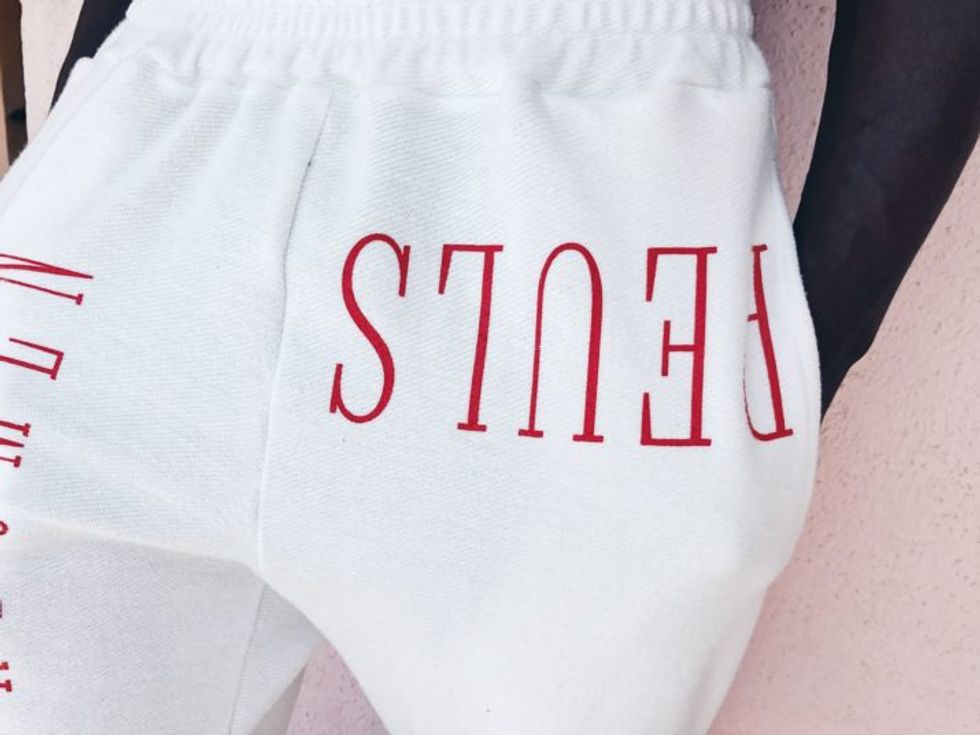First Look: VIZUVLGVDS New Capsule Collection
Photos from the new herdsman-inspired capsule collection from VIZUVLGVDS.

Last week we went in depth with Muktar Onifade the artist and designer behind the fashion line VIZUVLGVDS. He revealed his fashion inspirations, his creative plans and his vision of African-inspired looks without the wax print.
Today we bring you a first look at the VIZUVLGVDS capsule collection including the Herdsman Shorts and the Fulani Tee.
According to Onifade “The vision behind this capsule series is to create high quality cut & sew pieces that highlight the unique heritage and legacy of various indigenous tribes in Africa.”
In this particular instance Onifade is taking inspiration from the Nuer scarification rights. As they write on their site:
The Nuer receive facial markings (called gaar) as part of their initiation into adulthood. The pattern of Nuer scarification varies within specific subgroups. The most common initiation pattern among males consists of six parallel horizontal lines which are cut across the forehead with a razor, often with a dip in the lines above the nose. Dotted patterns are also common (especially among the Bul Nuer and among females).
They used to make scars across their main foreheads. The marks are of six lines. Ustaz Paul Chuol Puoch who narrated that, the scar marks are made in the forehead of the man to make him be known to the people that he is a Nuer by tribe. He says that these marks represent some informal constitutional articles. "They are in form of law, plus traditional rules and customs as well as law of kinship," he explained. He said the following article interprets the meaning of the scar-marks. "The first mark denotes that you should not bother yourself with the small children. You must know that you have reached the age of manhood. The second scar mark signifies that you must not be afraid of anybody. You must know that you are an adolescent and not dependent on your parents.
The third scar mark advocates that you should not steal or make any mistakes, that means you must avoid scandalous things. You must participate in the defense of the public and you must handle the family or deal well with the household. The fourth scar mark advocates that you should not just eat in any place and you must be an honorable young man. The fifth scar mark signifies that you should not be greedy or gluttonous or covetous The last and sixth scar mark advocates that you should not make or commit adultery with the wife of another man or with girls who are related to you especially the ones that have some blood relations. It is incest taboo and causes death or disgrace to the defaulters. All these laws are introduced to the boys who have received their head scar marks after the initiation. After they are initiated, the old man comes up to address them.
Before the boys receive the scar marks, some oxen or bulls are slaughtered for sacrifice to God. During the slaughter of the oxen, an old man and another elderly man make a very big ceremony as wedding praying to God that nothing should happen to the boys who are going to receive the marks. In fact many prayers are conducted because sometimes death may occur during the marking event. Sometimes the markings can cause much bleeding leading to the death of the boy being initiated. If it happens to one boy suddenly there is no charge, no condemnation. It is just like an operation in the hospital, somebody who does the operation is regarded a doctor who is making an operation on the patient. If a patient happens to die, the doctor is not charged to pay compensation because he was trying to save the patient's life. The man who marks is well trained about this experience. If anything occurs, nobody can charge him to pay compensation. But it is very rare to happen. It is put into Nuer law and blessed. The people pray much to God. They believe that the Almighty God gives them these marks
See images from the collection below:







